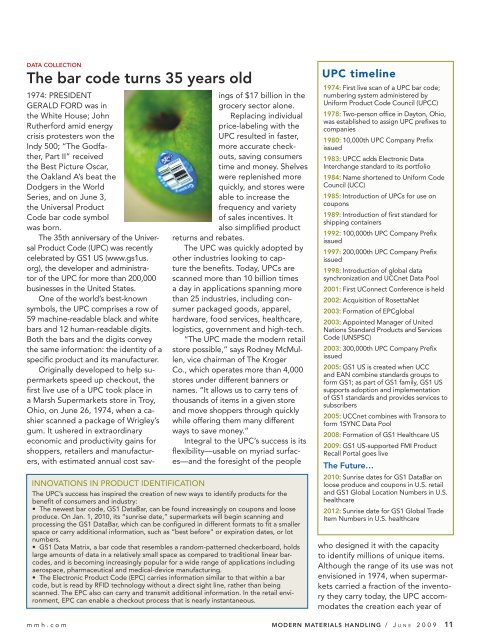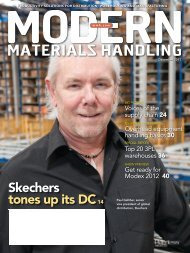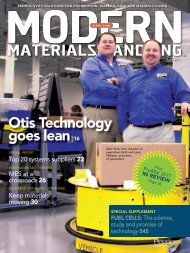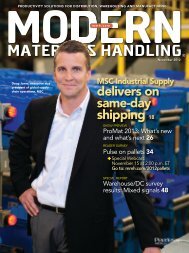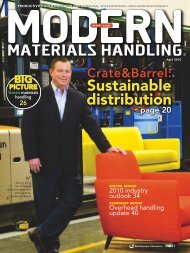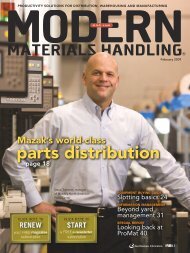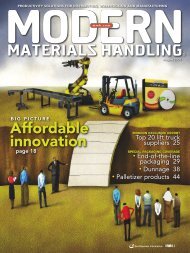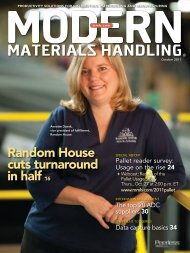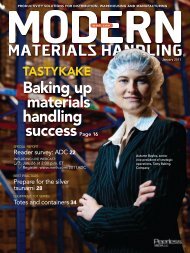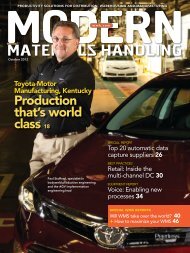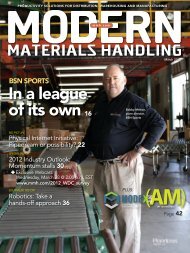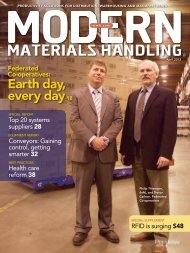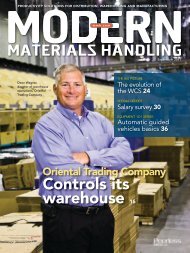June - Modern Materials Handling
June - Modern Materials Handling
June - Modern Materials Handling
- No tags were found...
You also want an ePaper? Increase the reach of your titles
YUMPU automatically turns print PDFs into web optimized ePapers that Google loves.
DATA COLLECTIONThe bar code turns 35 years old1974: PRESIDENTGERALD FORD was inthe White House; JohnRutherford amid energycrisis protesters won theIndy 500; “The Godfather,Part II” receivedthe Best Picture Oscar,the Oakland A’s beat theDodgers in the WorldSeries, and on <strong>June</strong> 3,the Universal ProductCode bar code symbolwas born.The 35th anniversary of the UniversalProduct Code (UPC) was recentlycelebrated by GS1 US (www.gs1us.org), the developer and administratorof the UPC for more than 200,000businesses in the United States.One of the world’s best-knownsymbols, the UPC comprises a row of59 machine-readable black and whitebars and 12 human-readable digits.Both the bars and the digits conveythe same information: the identity of aspecific product and its manufacturer.Originally developed to help supermarketsspeed up checkout, thefirst live use of a UPC took place ina Marsh Supermarkets store in Troy,Ohio, on <strong>June</strong> 26, 1974, when a cashierscanned a package of Wrigley’sgum. It ushered in extraordinaryeconomic and productivity gains forshoppers, retailers and manufacturers,with estimated annual cost savingsof $17 billion in thegrocery sector alone.Replacing individualprice-labeling with theUPC resulted in faster,more accurate checkouts,saving consumerstime and money. Shelveswere replenished morequickly, and stores wereable to increase thefrequency and varietyof sales incentives. Italso simplified productreturns and rebates.The UPC was quickly adopted byother industries looking to capturethe benefits. Today, UPCs arescanned more than 10 billion timesa day in applications spanning morethan 25 industries, including consumerpackaged goods, apparel,hardware, food services, healthcare,logistics, government and high-tech.“The UPC made the modern retailstore possible,” says Rodney McMullen,vice chairman of The KrogerCo., which operates more than 4,000stores under different banners ornames. “It allows us to carry tens ofthousands of items in a given storeand move shoppers through quicklywhile offering them many differentways to save money.”Integral to the UPC’s success is itsflexibility—usable on myriad surfaces—andthe foresight of the peopleINNOVATIONS IN PRODUCT IDENTIFICATIONThe UPC’s success has inspired the creation of new ways to identify products for thebenefit of consumers and industry:• The newest bar code, GS1 DataBar, can be found increasingly on coupons and looseproduce. On Jan. 1, 2010, its “sunrise date,” supermarkets will begin scanning andprocessing the GS1 DataBar, which can be configured in different formats to fit a smallerspace or carry additional information, such as “best before” or expiration dates, or lotnumbers.• GS1 Data Matrix, a bar code that resembles a random-patterned checkerboard, holdslarge amounts of data in a relatively small space as compared to traditional linear barcodes,and is becoming increasingly popular for a wide range of applications includingaerospace, pharmaceutical and medical-device manufacturing.• The Electronic Product Code (EPC) carries information similar to that within a barcode, but is read by RFID technology without a direct sight line, rather than beingscanned. The EPC also can carry and transmit additional information. In the retail environment,EPC can enable a checkout process that is nearly instantaneous.UPC timeline1974: First live scan of a UPC bar code;numbering system administered byUniform Product Code Council (UPCC)1978: Two-person office in Dayton, Ohio,was established to assign UPC prefixes tocompanies1980: 10,000th UPC Company Prefixissued1983: UPCC adds Electronic DataInterchange standard to its portfolio1984: Name shortened to Uniform CodeCouncil (UCC)1985: Introduction of UPCs for use oncoupons1989: Introduction of first standard forshipping containers1992: 100,000th UPC Company Prefixissued1997: 200,000th UPC Company Prefixissued1998: Introduction of global datasynchronization and UCCnet Data Pool2001: First UConnect Conference is held2002: Acquisition of RosettaNet2003: Formation of EPCglobal2003: Appointed Manager of UnitedNations Standard Products and ServicesCode (UNSPSC)2003: 300,000th UPC Company Prefixissued2005: GS1 US is created when UCCand EAN combine standards groups toform GS1; as part of GS1 family, GS1 USsupports adoption and implementationof GS1 standards and provides services tosubscribers2005: UCCnet combines with Transora toform 1SYNC Data Pool2008: Formation of GS1 Healthcare US2009: GS1 US-supported FMI ProductRecall Portal goes liveThe Future…2010: Sunrise dates for GS1 DataBar onloose produce and coupons in U.S. retailand GS1 Global Location Numbers in U.S.healthcare2012: Sunrise date for GS1 Global TradeItem Numbers in U.S. healthcarewho designed it with the capacityto identify millions of unique items.Although the range of its use was notenvisioned in 1974, when supermarketscarried a fraction of the inventorythey carry today, the UPC accommodatesthe creation each year ofmmh.com MODERN MATERIALS HANDLING / JUNE 2009 11


